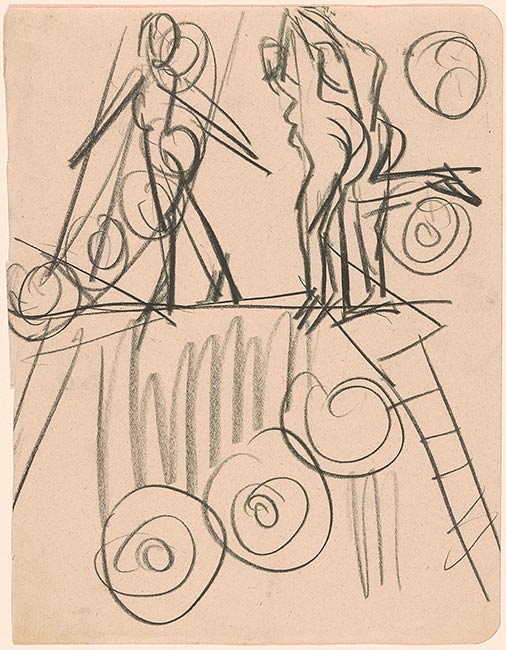
Scenes of urban entertainment were a popular theme in German Expressionist art, and they first appear in Kirchner's work in 1908. While living in Berlin and Dresden, Kirchner frequented the cabaret and circus, and in this energetic drawing he captures the precarious poise of a troupe of tightrope walkers aloft the high wire. The swirling forms circling around the performers, perhaps depicting spotlights, vividly suggest the sense of vertigo and dizzying height that at once thrilled and terrified spectators. Though Kirchner produced a number of paintings on this theme, such as "Trapeze Acrobats in Blue" (1914, Private Collection located at Kunstsammlung Nordhein-Westfalen, Dusseldorf), his drawings tended to serve as informal explorations rather than preparatory studies for specific paintings. The loose and sketchy line in this drawing is stylistically akin to works produced in the artist's sketchbook from 1909-10. (Lloyd 2003, nos. 27-28). The subject of the tightrope walker carried profound resonances for Kirchner. In search of the "primitive" in the modern world, he found in the circus performers a sense of liberated energy, sexuality, and sensory immediacy which suggested new possibilities for the fusion of art and life beyond the rigid formalities of bourgeois culture. More specifically, the tightrope walker stood as an emblematic figure in Friedrich Nietzche's "Thus Spoke Zarathustra", a formative text of Die Brucke group's aesthetic philosophy as well as the source of its name. In the prologue of this text, Nietzsche's philosopher pronounces, "Man is a rope. A rope over an abyss. A dangerous going-across." For Nietzsche, the tightrope walker challenged human limitations in an act of defiance against gravity, thus symbolizing the possibility of self-transcendence that could arise from a life experienced in the intensity of the present moment.
